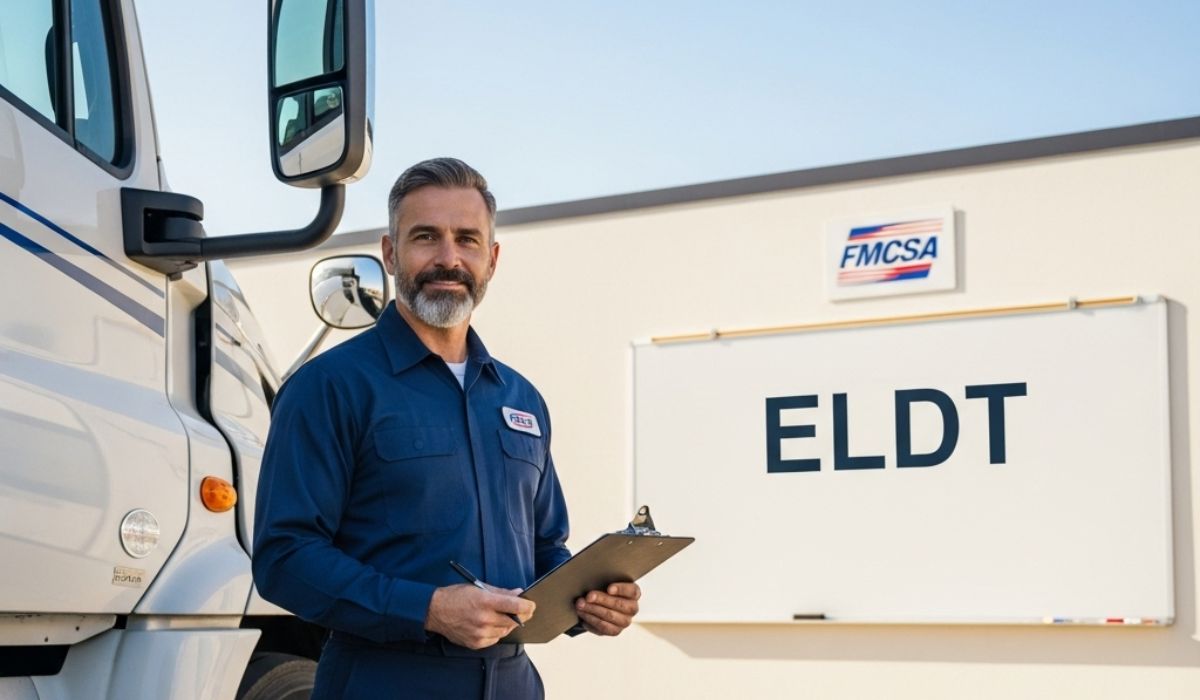Every driver and driving training institution is aware of ELDT training and the new national standards set by the administration. It’s important to learn about the term for both trainees and trainers. Let’s properly understand ELDT training and its importance in commercial driving in the USA.
What is ELDT Training?
ELDT training stands for Entry-Level Driver Training of a Federal standard. Every person who wants to drive a commercial vehicle in the United States is familiar with this term. It’s a mandatory requirement for anyone who wants a specific kind of Commercial Driver’s License (CDL). It’s basically training people for entry-level driving skills with the aim of making new drivers educated enough before getting behind the wheel of large vehicles like trucks or buses.
The rule was introduced by the Federal Motor Carrier Safety Administration (FMCSA) and officially implemented on February 7, 2022. Before this date, CDL training programs varied from one state to another. But now, ELDT sets a national standard. However, the training providers must follow the minimum commercial driving education level to continue their services as driving institutions.
Training providers first certify with the FMCSA. They make sure that their driving programs meet the minimum commercial driving education standards. After approval, they can continue teaching and training commerce drivers.
The FMCSA Training Provider Registry keeps all the records related to ELDT training. It includes all CDL applicant data who have completed the ELDT training and certification process. Overall, this new ELDT training process is necessary for novice commercial drivers and training providers. This training helps in keeping driving standards consistent across the country. It makes sure that every driver remains safe and duty-bound while working behind the wheel on the road.
Who Needs ELDT Training?
Applicants for CDL don’t necessarily need ELDT training. It applies only to specific cases. People who apply for a Class A or Class B CDL for the first time need to complete ELDT; after that, they can take the skill test. All licensed drivers who want to upgrade their current license, for example, moving from Class B to Class A, need to pass this training. In the third case, the training is necessary to pass when you want to add certain endorsements like passenger (P), school bus (S), or hazardous materials (H) for the first time.
But there are some exemptions also, like
- Having a CDL or relevant endorsements before February 7, 2022
- People who have a Commercial Learner’s Permit (CLP) before the ELDT official start date
What Does ELDT Training Include?
ELDT training has both theory and behind-the-wheel training. A trainee has to successfully complete both sections, and then they are eligible for testing.
Theory Training
Theory training comprises classroom or online classes. It covers basic knowledge that every commercial driver needs, like
- How the vehicle works
- Road and driving safety rules
- Reporting systems
- Hours of service
- Drug and alcohol awareness
Classes have no fixed hours, but the applicant must pass a written exam with an 80% score.
Behind-the-Wheel Training
It’s hands-on driving training where applicants get training in real commercial vehicles. This training completes in two settings. The first one is a closed course or range, and the second is on public roads. The skills you’ll practice in this setting are:
- basic control
- turning
- backing up
- lane changes
- emergency stops, and more.
Like the previous, this setting also doesn’t have fixed hours, but your instructor must sign off that you’ve gained the required skills.
What Are the Main Topics Covered?
ELDT training is very thorough. Some of the key subjects include:
- Basic vehicle control
- Pre-trip inspections
- Safe driving habits
- Handling emergency situations
- Using mirrors and managing blind spots
- Loading and securing cargo
- Vehicle maintenance and reporting
- Dealing with hazardous road conditions
- Avoiding driver fatigue
- Federal and state laws, especially for HAZMAT
The course is basic for simple commercial drivers, but those who apply for endorsements need to cover extra topics. One example is a hazardous materials endorsement. This training includes rules for transporting dangerous goods and safety procedures in case of leaks or accidents.
How to Take ELDT Training?
Applicants only take ELDT training from a training provider listed on the FMCSA’s Training Provider Registry (TPR). Not all driving schools are offering ELDT courses. You can find the approved trainers list on the FMCSA’s official website.
Join the training provider and complete your theory and behind-the-wheel training. After completion, your provider will submit proof of your training completion to the FMCSA database. After this, you can schedule your CDL skills test at the DMV.
Conclusion
ELDT training is a new rule in the USA to become a commercial vehicle driver. It benefits the trucking and transportation industry by making them more responsible and professional. ELDT is important as it’s not just a test to pass, but it also helps drivers to better drive their vehicles in tough situations.
Start by searching for a registered training provider to properly and seriously complete the course. Focus on your training and ask questions if you have. Work hard to pass it. Your better preparation not only makes you able to pass your CDL test but also helps you start your career on the right foot.
Note: This article is provided by CDLeXpert and published by our team. We are not responsible for the accuracy of the information provided.




